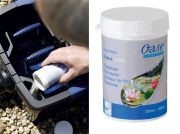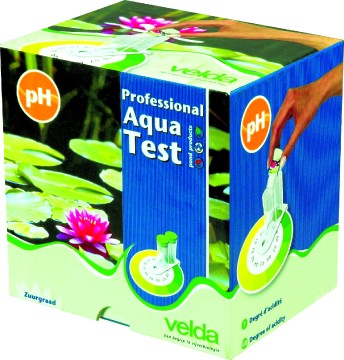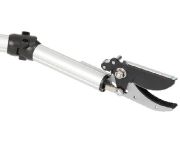Spring Pond Care Tips
Once the water temperature begins to warm up, your pond fish begin to awaken from their winter rest and go in search of food. Fish will be at their most vulnerable at this time of the year as they begin to reacclimatise to warmer water and recover from the Winter dormancy that will have left them feeling rather weak and sluggish. You can help to make your fish feel more comfortable and healthy using our guide to Spring pond care.
Pond Filter Reactivation & Maintenance
 If you have wound down your filtration system over the winter months, now is the time to restart the filter system and get this back up to full mechanical and biological effectiveness. Filter pumps should be switched on and if raised up over the winter, lowered back to the pond floor to pull in settling debris most effectively. Spring is the ideal time to carry out any maintenance the filter may require, from basic flushing out of dirt from the filter to equipping the system with fresh components to remain effective throughout the year.
If you have wound down your filtration system over the winter months, now is the time to restart the filter system and get this back up to full mechanical and biological effectiveness. Filter pumps should be switched on and if raised up over the winter, lowered back to the pond floor to pull in settling debris most effectively. Spring is the ideal time to carry out any maintenance the filter may require, from basic flushing out of dirt from the filter to equipping the system with fresh components to remain effective throughout the year.
 Give the filter foams a good squeeze in a bucket of pond water to remove any waste that may restrict water passage. If the filter foams are showing signs of wear or physical degradation, now is the ideal time to replace these as they are not biologically effective yet and will not become so until the filter has been fully operational and running for a few weeks. Kick start the biological activity within the pond filter by introducing a starter bacteria such as BioKick. This will bring the biological side of the filtration up to maximum effectiveness in a shorter space of time than it would take naturally.
Give the filter foams a good squeeze in a bucket of pond water to remove any waste that may restrict water passage. If the filter foams are showing signs of wear or physical degradation, now is the ideal time to replace these as they are not biologically effective yet and will not become so until the filter has been fully operational and running for a few weeks. Kick start the biological activity within the pond filter by introducing a starter bacteria such as BioKick. This will bring the biological side of the filtration up to maximum effectiveness in a shorter space of time than it would take naturally.
![]() Recharge filter zeolite media by soaking this in a bucket of salt water. This will cause the filter zeolite to purge out any nutrients and harmful ammonia that have been absorbed throughout the previous year and bring this back up to full effectiveness for the new pond season.
Recharge filter zeolite media by soaking this in a bucket of salt water. This will cause the filter zeolite to purge out any nutrients and harmful ammonia that have been absorbed throughout the previous year and bring this back up to full effectiveness for the new pond season.
UV Reactivation & Maintenance
 When the water temperature is consistently above 8ºC it is time to switch on your ultraviolet clarifier as single-celled algae will begin blooming at temperatures of 8ºC and above which can cause pond water to turn an unsightly bright green. If your UV lamp has not been replaced in the last 12-18 months, this will now be far less effective than when fitted, so Spring is the ideal time to replace the UV lamp for maximum efficiency in the warmer months to come.
When the water temperature is consistently above 8ºC it is time to switch on your ultraviolet clarifier as single-celled algae will begin blooming at temperatures of 8ºC and above which can cause pond water to turn an unsightly bright green. If your UV lamp has not been replaced in the last 12-18 months, this will now be far less effective than when fitted, so Spring is the ideal time to replace the UV lamp for maximum efficiency in the warmer months to come.
Feeding
 When temperatures are hitting around 10ºC you can begin feeding again (before if the fish are active and looking for food items). Start them off on a highly digestible low protein wheat-based diet, feeding little and often and ensuring all feed is consumed. When temperatures rise to around 12ºC and above, switch over to a higher protein fishmeal-based feed which can be digested in warmer temperatures. An automatic fish feeder can be used to regulate feeding doses and intervals to minimise manual feeding efforts and ensure the correct amount of fish food is applied consistently.
When temperatures are hitting around 10ºC you can begin feeding again (before if the fish are active and looking for food items). Start them off on a highly digestible low protein wheat-based diet, feeding little and often and ensuring all feed is consumed. When temperatures rise to around 12ºC and above, switch over to a higher protein fishmeal-based feed which can be digested in warmer temperatures. An automatic fish feeder can be used to regulate feeding doses and intervals to minimise manual feeding efforts and ensure the correct amount of fish food is applied consistently.
Water Temperature
 Biological occurrences begin to take affect at different key water temperatures, such as algae bloom and the speed of fish metabolism and their dietary needs. A pond thermometer will assist in determining water temperature. Different types available include hand held infrared thermometers and floating units. Many filtration systems such as the OASE BioSmart filters feature inbuilt thermometers which allow for constant monitoring of the water temperature throughout the year.
Biological occurrences begin to take affect at different key water temperatures, such as algae bloom and the speed of fish metabolism and their dietary needs. A pond thermometer will assist in determining water temperature. Different types available include hand held infrared thermometers and floating units. Many filtration systems such as the OASE BioSmart filters feature inbuilt thermometers which allow for constant monitoring of the water temperature throughout the year.
Water Testing
 Water parameters can be subject to some fluctuation as the water begins to warm and the pond biology that has been dormant springs into life. A good quality water testing kit will allow you to keep a close eye key levels of harmful ammonia and nitrite, algae inducing nitrate and phosphate, chemical content such as chlorine, trace metals iron and copper and values pH and hardness. From these results you can identify potential problems and act accordingly to prevent water quality and fish health issues.
Water parameters can be subject to some fluctuation as the water begins to warm and the pond biology that has been dormant springs into life. A good quality water testing kit will allow you to keep a close eye key levels of harmful ammonia and nitrite, algae inducing nitrate and phosphate, chemical content such as chlorine, trace metals iron and copper and values pH and hardness. From these results you can identify potential problems and act accordingly to prevent water quality and fish health issues.
Dead Plants & Debris
 Any dead plant matter and debris that have entered the pond over winter should be removed before the water becomes sufficiently warm for decomposition to set in. Dying plants should be pruned with pond scissors and settled debris on the pond floor sucked out using a pond vacuum cleaner or collected using a long handled pond net with a fine mesh.
Any dead plant matter and debris that have entered the pond over winter should be removed before the water becomes sufficiently warm for decomposition to set in. Dying plants should be pruned with pond scissors and settled debris on the pond floor sucked out using a pond vacuum cleaner or collected using a long handled pond net with a fine mesh.
Fish Health
 Keep an eye on your fish during the Spring as they will be vulnerable and weak after the Winter. Look out for signs of poor health such as visible ulcers, excess mucus and ‘flashing’ and rubbing that would indicate parasite infection. Treat any health issues with a suitable fish medication.
Keep an eye on your fish during the Spring as they will be vulnerable and weak after the Winter. Look out for signs of poor health such as visible ulcers, excess mucus and ‘flashing’ and rubbing that would indicate parasite infection. Treat any health issues with a suitable fish medication.
Whist the fish are adjusting to the new season they may be sluggish and slow to react to potential threats leaving them particularly vulnerable to garden pond predators such as herons keen to take advantage as the fish start to rise back to the surface of the pond after wintering on the pond floor. There are many products available to prevent predator access and deter them from visiting your pond, pond cover nets, decoy herons and low voltage electric fences can all be effective.
With the right preparation and nurturing, a garden pond can flourish during the Spring as the days become longer, the temperature rises and all aquatic life begins to reemerge.


